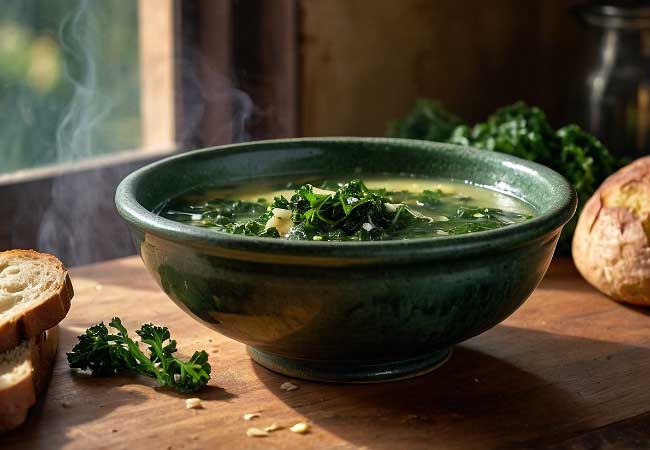MyPortugalHoliday.com
The best independent guide to Portugal
MyPortugalHoliday.com
The best independent guide to Portugal
A Taste of Portugal: A Guide to Famous Dishes & Regional Cuisine
Portugal's culinary landscape is a rich reflection of its history, born from centuries of maritime exploration and an intimate connection to its land and sea. This heritage is served on every plate, from the iconic Pastel de Nata of Lisbon to the hearty stews of the mountainous north and the fresh grilled sardines enjoyed along its endless coastline. It is a cuisine of bold flavours, regional pride, and deceptively simple preparations that celebrate high-quality ingredients.
To truly understand Portuguese food is to travel the country through its flavours. In Porto, you'll discover the indulgent Francesinha sandwich, while the southern Algarve offers the fiery kick of Frango Piri-Piri. The Alentejo plains provide the hearty Carne de Porco à Alentejana-a unique combination of pork and clams-while the comforting embrace of Bacalhau à Brás can be found nationwide, just one of hundreds of ways the Portuguese prepare their beloved salt cod.
This guide introduces the most famous dishes and regional specialities of Portugal, exploring the stories and flavours behind each one. Prepare for a gastronomic journey through one of Europe’s most authentic and rewarding culinary destinations.
Francesinha - Portugal’s Formidable Sandwich
The Francesinha is Porto’s audacious and iconic contribution to the world of sandwiches. A formidable construction of bread, ham, linguiça sausage, steak, and roast meat, it is encased in melted cheese and then drenched in a rich, spiced tomato and beer sauce. Often crowned with a fried egg and flanked by chips, this is not a snack but a substantial, knife-and-fork meal.
Its origin is a classic story of culinary adaptation. In the 1950s, a returned Portuguese emigrant named Daniel David de Silva, inspired by the French croque-monsieur, set out to create a version with a boldness better suited to the Portuguese palate. He unveiled his creation in 1953 at the restaurant A Regaleira, and Porto’s most famous dish was born. While fiercely traditional, inventive chefs now offer seafood or vegetarian versions, but the meaty original remains the standard-bearer.
Frango Piri-Piri - A Taste of the Spice Trade
Frango Piri-Piri, or Piri-Piri Chicken, is Portugal's globally recognised grilled chicken dish, a direct and fiery taste of the nation's age of exploration. The key to its character is the potent Piri-Piri chili, also known as the African Bird's Eye. The chicken is spatchcocked and marinated in a pungent blend of these chilies, garlic, olive oil, and lemon before being grilled over hot charcoal.
The dish tells a remarkable story of global food exchange. In the 15th century, Portuguese explorers carried the chili from its native Americas to their African colonies of Angola and Mozambique. There, the chili was cultivated and integrated into local cuisine, leading to the creation of the piquant marinade.
Portuguese settlers eventually brought this recipe home, where it became intrinsically linked with the Algarve. Today, the town of Guia is regarded as the spiritual home of Frango Piri-Piri in Portugal, with local restaurants fiercely guarding their secret family recipes.
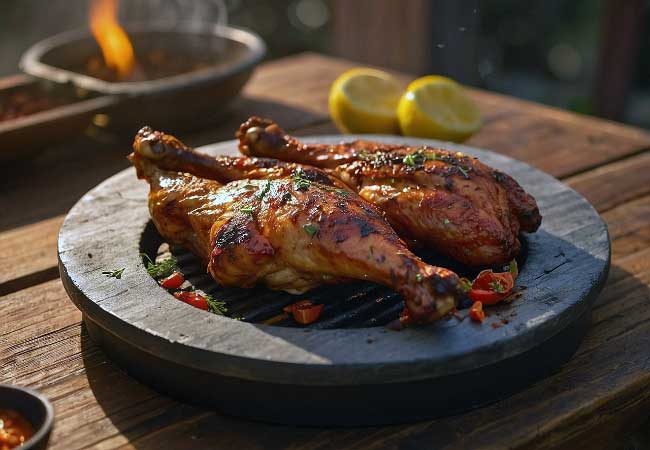
Arroz de Marisco - The Ocean in a Pot
Arroz de Marisco is Portugal’s definitive seafood and rice dish, a generous and soupy celebration of the Atlantic. Unlike the dry Spanish paella, this dish is defined by its wet consistency (malandrinho), with the rice swimming in a flavour-packed broth. A bounty of shellfish, typically prawns, clams, and mussels, sometimes with crab or lobster, is simmered with short-grain rice, onions, tomatoes, and garlic.
Arroz de Marisco is Portugal’s definitive seafood and rice dish, a generous and soupy celebration of the Atlantic. Unlike the dry Spanish paella, this dish is defined by its wet consistency (malandrinho), with the rice swimming in a flavour-packed broth. A bounty of shellfish-typically prawns, clams, and mussels, sometimes with crab or lobster-is simmered with short-grain rice, onions, tomatoes, and garlic.
Bacalhau à Brás - The Ultimate Comfort Food
Of the hundreds of ways the Portuguese prepare their cherished salt cod (bacalhau), none is more comforting or ubiquitous than Bacalhau à Brás. This is the nation’s soul food, a deceptively simple dish of shredded salt cod tossed with hand-cut, pan-fried potato slivers, caramelised onions, and scrambled eggs. Finished with a scattering of black olives and fresh parsley, it is a perfect harmony of textures and savoury flavours.
The dish is believed to have been created in the late 19th century in Lisbon’s Bairro Alto district by a tavern owner named Braz (an archaic spelling of Brás). The genius of the recipe was its use of leftover cod, transforming humble ingredients into a beloved classic. The "à Brás" style, shredded main ingredient with fried potato and egg, has become so popular that it is now applied to other ingredients, such as chicken (frango à Brás).
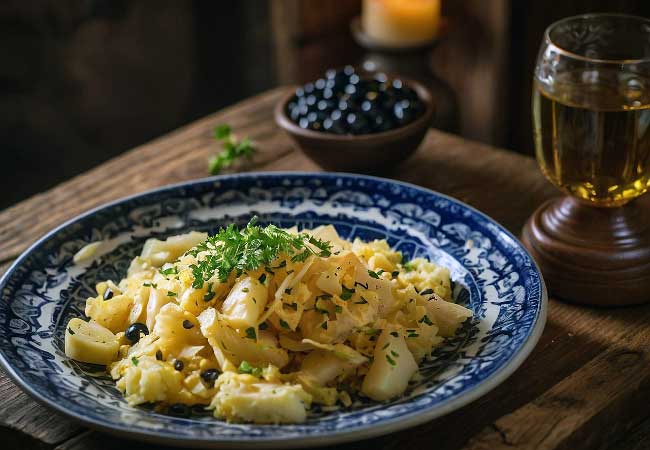
Prego - The Essential Steak Sandwich
The Prego is Portuguese fast food at its finest, a simple, satisfying, and flavourful steak sandwich. A thin beef steak is marinated in garlic, grilled, and served on a crusty roll (papo seco). The name Prego (nail) is thought to refer to the method of pounding slices of garlic into the meat. While often served simply with mustard, variations include the addition of a fried egg (Prego no Prato) or sautéed onions.
Born in the late 19th century at a tavern near Praia das Maçãs in the Sintra region, the Prego quickly became a staple across the country, from bustling city tascas to beachside cafés. It is a true working-class classic, beloved for its robust garlic flavour and the quality of its simple ingredients. It is often eaten as a main course for lunch or, famously, as a "dessert" after a large seafood meal.
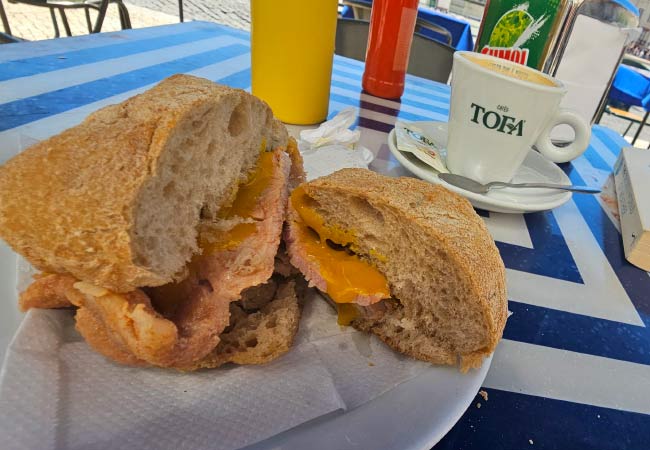
Sardinhas Assadas - The Icon of Summer
Sardinhas Assadas (grilled sardines) are the culinary symbol of a Portuguese summer. The preparation is deceptively simple and honours the quality of the fresh fish. Plump sardines, caught when they are at their fattest between June and September, are tossed in coarse sea salt and grilled whole over hot charcoal. The result is a crispy, salty skin that yields to tender, oily flesh with a profound flavour.
This dish is inseparable from the summer Festas dos Santos Populares (Feasts of the Popular Saints) in June, particularly in Lisbon and Porto. During these festivals, entire neighbourhoods are filled with the smoke and irresistible aroma of sardines grilling on street-corner barbecues. Traditionally served atop a slice of rustic bread to soak up the juices and accompanied by a simple salad of grilled peppers, this is Portuguese food at its most elemental and joyous.
Beyond their gastronomic appeal, sardines hold cultural significance in Portugal. They feature prominently in art and ceramics, symbolising the nation's coastal identity. The canning industry, which began in the 19th century, further cemented sardines' importance in Portugal’s cultural identity.
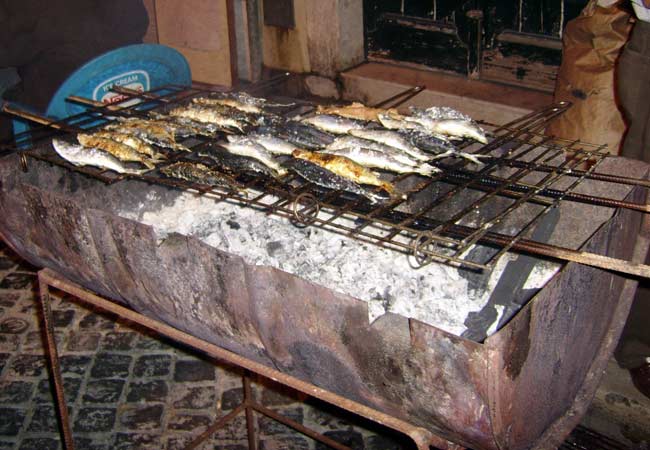
Leitão Assado - A Bairrada Delicacy
Leitão Assado, succulent roasted suckling pig, is a celebrated delicacy intrinsically linked to the Bairrada region, particularly the town of Mealhada. A young pig, typically only four to six weeks old, is seasoned simply with a paste of garlic and salt. It is then slow-roasted for hours on a spit over a wood fire until the meat is incredibly tender and the skin has transformed into a perfectly crisp, golden-brown cracker.
This dish is reserved for celebrations and special occasions. The pigs raised in the Bairrada region, often fed on acorns, are considered the finest in Portugal, lending the meat a distinctive, delicate flavour. Served with potato crisps, orange slices, and a piquant pepper sauce, Leitão Assado is a testament to the Portuguese art of slow-roasting.
Cataplana de Marisco - A Theatrical Seafood Stew
The Cataplana de Marisco is the signature dish of the Algarve, a magnificent seafood stew that is as theatrical in its presentation as it is rich in flavour. A medley of fresh fish, clams, mussels, and prawns is layered with slices of pepper, onion, and tomato, then simmered in a broth of white wine and herbs.
The dish takes its name from the unique copper cooking vessel in which it is both cooked and served. The cataplana, a hinged, clam-shaped pan, is thought to be a legacy of the Moors who occupied the region for centuries, its design sharing similarities with the North African tagine. It functions like a primitive pressure cooker, sealing in the steam and forcing the flavours of the ingredients to meld together. The pot is brought sealed to the table, where it is opened to release a fragrant cloud of steam in a moment of pure culinary drama.
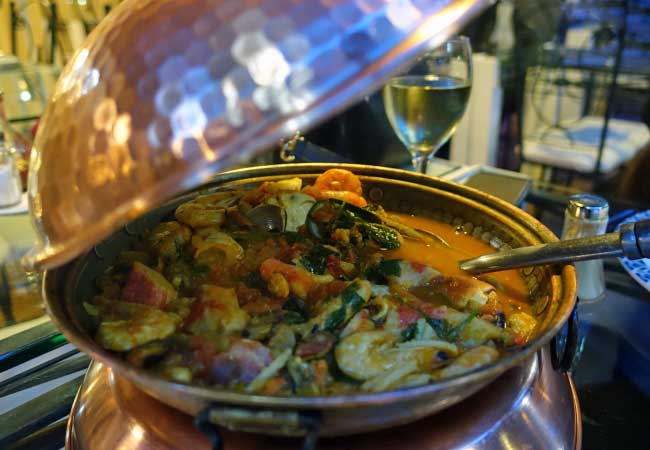
Arroz de Pato - The Ultimate Duck and Rice
Arroz de Pato (Duck Rice) is a classic of Portuguese home cooking, a rich and deeply savoury oven-baked rice dish. A whole duck is first simmered until tender in a flavourful broth with wine and aromatics. The meat is then shredded and layered with rice that has been cooked in the same duck-infused liquid. The dish is topped with slices of smoky chouriço sausage and baked until a delicious, golden-brown crust forms.
While enjoyed throughout the country, Arroz de Pato is often associated with the northern city of Braga. Traditionally baked in a terracotta casserole dish, its appeal lies in the layers of flavour: the rich, gamey duck, the savoury rice, the smoky sausage, and the satisfyingly crisp topping. It is a masterpiece of using every part of the animal to build profound depth.
Carne de Porco à Alentejana - A Surprising Union
Carne de Porco à Alentejana is one of Portugal's most famous and curious culinary creations, a brilliant combination of marinated pork and fresh clams. Cubes of pork are marinated in white wine, paprika, garlic, and bay leaves, then fried until golden. The clams are added at the end, steaming open and releasing their briny liquor to create a sauce. The dish is traditionally garnished with fresh coriander and served with fried potatoes.
Despite its name, which translates to "Pork, Alentejo-style," historical evidence suggests the dish originated not in the inland Alentejo but on the coast of the Algarve. The most popular theory is that a restaurant named "A Alentejana" first popularised the dish, leading to the geographical misnomer. Regardless of its origin, this "surf and turf" combination is a staple across the country, a testament to Portuguese culinary ingenuity.
Caldo Verde - The National Soup
Caldo Verde is arguably Portugal’s national soup, a simple yet deeply satisfying dish found in every home and restaurant. Its foundation is a creamy potato and onion purée, into which is stirred a mass of finely shredded collard greens (or kale). The greens are sliced so thinly they resemble ribbons, which wilt into the hot soup, giving it its name, "Green Broth." A slice of smoky chouriço is often added just before serving, its paprika-infused oil bleeding into the pale broth.
Originating as a humble peasant dish in the northern Minho province, Caldo Verde was a nutritious and affordable way to feed a family. Its appeal spread across the nation, becoming a staple appetiser and a traditional feature at festivals and celebrations. It embodies the essence of Portuguese cooking: transforming simple, high-quality ingredients into something truly magnificent.
